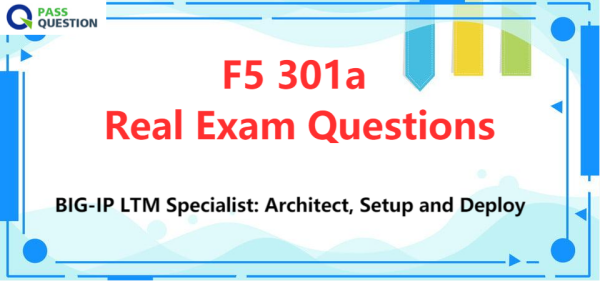F5 301a Real Exam Questions - BIG-IP LTM Specialist: Architect, Setup and Deploy
How to prepare for F5 301a BIG-IP LTM Specialist: Architect, Setup and Deploy Exam? You can come to PassQuestion to choose the latest F5 301a Real Exam Questions online. There are 147 practice questions and answers for you to practice. F5 301a Real Exam Questions can be trust, which are valid for passing F5 301a exam.PassQuestion new F5 301a Real Exam Questions are based on the F5 301a exam objectives. After learn all F5 301a Real Exam Questions, you can pass BIG-IP LTM Specialist: Architect, Setup and Deploy 301a exam in the first attempt.

About The 301a-LTM Specialist: Architect, Set-up & Deploy Exam
The 301a-LTM Specialist: Architect, Set-up & Deploy exam is one of two exams required to achieve Certified F5 Technology Specialist, LTM status. Individuals who pass this exam possess an of underlying principles – from SSLbased VPN implementation to symmetric and asymmetric acceleration – and can draw on that insight to integrate BIG-IP Local Traffic Manager (LTM) into existing networks as well as new implementations. This is exam 1 of 2 and is based on TMOS v11.
The F5 Certified Big-IP Administrator (F5-CA), which is made up of the 101 - App Delivery Fundamentals and 201 - TMOS Administration exams, stands as a pre-requisite to this exam.
Taking certified F5 LTM training, such as Administering BIG-IP v11 and Configuring BIG-IP LTM v11, will surely help with the topics of this exam but does not teach directly to the exam content. Hands on administrative experience with the Big-IP platform licensed with LTM will reinforce many of the topics contained in the 301a - LTM Specialist exam.
F5 301a LTM Specialist Exam Objectives
Section 1: Architect an application
Objective 1.01 Given an expected traffic volume, determine the appropriate SNAT configuration
Objective 1.02 Given a scenario, determine the minimum profiles for an application
Objective 1.03 Given an application configuration, determine which functions can be offloaded to the LTM device
Objective 1.04 Given an application configuration, determine which functions can be offloaded to the LTM device
Objective 1.05 Given an application configuration, determine the appropriate profile and persistence options
Objective 1.06 Explain the steps necessary to configure AVR U/A
Objective 1.07 Given a set of reporting requirements, determine the AVR metrics and entities to collect
Objective 1.08 Given a scenario, determine the appropriate monitor type and parameters to use
Objective 1.09 Given a set of parameters, predict an outcome of a monitor status on other LTM device objects
Objective 1.10 Given a set of SSL requirements, determine the appropriate profile options to create or modify in the SSL profile
Objective 1.11 Given a set of application requirements, describe the steps necessary to configure SSL
Objective 1.12 Given a set of application requirements, determine the appropriate virtual server type to use
Objective 1.13 Given a set of application requirements, determine the appropriate virtual server configuration settings
Objective 1.14 Explain the matching order of multiple virtual servers U/A
Objective 1.15 Given a scenario, determine the appropriate load balancing method(s)
Objective 1.16 Explain the effect of LTM device configuration parameters on load balancing decisions
Section 2: Set-up, administer, and secure LTM devices
Objective 2.01 Distinguish between the management interface configuration and application traffic interface configuration
Objective 2.02 Given a network diagram, determine the appropriate network and system settings (i.e., VLANs, selfIPs, trunks, routes, NTP servers, DNS servers, SNMP receivers and syslog servers)
Objective 2.03 Given a network diagram, determine the appropriate physical connectivity U/A
Objective 2.04 Explain how to configure remote authentication and multiple administration roles on the LTM device
Objective 2.05 Given a scenario, determine an appropriate high availability configuration (i.e., failsafe, failover and timers)
Objective 2.06 Given a scenario, describe the steps necessary to set up a device group, traffic group and HA group
Objective 2.07 Predict the behavior of an LTM device group or traffic groups in a given failure scenario
Objective 2.08 Determine the effect of LTM features and/or modules on LTM device performance and/or memory
Objective 2.09 Determine the effect of traffic flow on LTM device performance and/or utilization
Objective 2.10 Determine the effect of virtual server settings on LTM device performance and/or utilization
Objective 2.11 Describe how to deploy vCMP guests and how the resources are distributed R
Objective 2.12 Determine the appropriate LTM device security configuration to protect against a security threat
Section 3: Deploy applications
Objective 3.01 Describe how to deploy and modify applications using existing and/or updated iApp application templates
Objective 3.02 Given application requirements, determine the appropriate profiles and profile settings to use
Objective 3.03 Determine the effect of traffic flow on LTM device performance and/or utilization
- TOP 50 Exam Questions
-
Exam
All copyrights reserved 2025 PassQuestion NETWORK CO.,LIMITED. All Rights Reserved.

